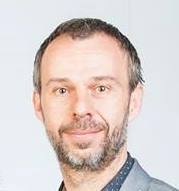On his fresh professorship and the potential of anatomy with Professor David Kachlík

Professor David Kachlík was handed his professorial decree by the minister of education, youth and sports Kateřina Valachová on 21 June 2016 in the Aula Magna of the Carolinum. Read below the interview with the new professor.
Prof. MUDr. David Kachlík, Ph.D., graduated from the Charles University Third Faculty of Medicine in 1998. Since the year 2000, he has been an assistant and lecturer at the Department of Anatomy of the Third Faculty; in 2006, he completed his doctoral degree in biomedicine and habilitated in 2010. Since 2015 he is the head of the Charles University Second Faculty's Department of Anatomy (the interview conducted on this occasion is available here).
Professor, where have you advanced professionally since your habilitation?
I believe that it is not easy to evaluate one's own expertise. For me, the habilitation opened doors to collaborations on more specialized books on clinical medicine. I think that my knowledge began to diversify more and that I stopped being an expert solely on small sections of anatomy, which is what I attended to during my time as a PhD student and young scientist. I had the opportunity to appear at specialized conventions of interventional cardiologists, angiologists, phlebologists, orthopaedists, urologists, gynaecologists, coloproctologists, and physiotherapists. Likewise, I began to dedicate myself to the two overlooked areas of my field: variational anatomy and the history of anatomy. And I keep realizing how little I know.
Did your interests as scientist and academic change since then, for example in how much you enjoy teaching, the amount of time you spend researching, is there an area that you used to devote yourself to less or not at all?
I highly enjoy teaching and I hope that my students do not see the time spent in my classes as pointless and lost. Unfortunately, I stopped teaching practical seminars after the transition from the Third Faculty of Medicine to ours due to time constraints. I give lectures to students and spend together the entire periods of their dissection tutorials, so luckily I did not lose direct contact with them. Sometimes I go observe the practical seminars to see how the younger teachers and lectors are doing, and I must say that they are skilful.
You had given an inaugural lecture on ‘Significance of clinical anatomy in contemporary education and research’. In a nutshell, what was it about?
Today, there are as many anatomologists as there is saffron. And most of them have dedicated their scientific activity to molecular biology, because modern science currently moves on a subcellular level. Even so, one can still find unexplained or inaccurately (and sometimes even incorrectly) described structures in the human body and with the advancement of surgical fields, diagnostics and medical procedures, the perception of individual structures changes and sometimes, aspects that need to be illuminated or clarified move into the foreground. This is taken care of by clinical anatomy, a field that does not provide only one scientific subject for life-long research, as it is a case of a stained glass piece that completes a mosaic of our current morphological knowledge. So much for research. The position of anatomy is central and irreplaceable in medical tuition, as the students will become doctors and knowledge of anatomy is not so fundamental by itself, but its usage in clinical medicine is essential. That is why also our tutoring needs to shift from simple descriptions of anatomical structures towards a viewpoint that gives the students information about their basic function, clinical significance, depiction in diagnostic methods and also variability. In short, I wanted to emphasize that every department of anatomy should have its own clinical anatomist who would diversify the tutorial and help with research.
How did you prepare for the lecture?
I confess that I jotted down some points and that was it. I prepared two introductory sentences and a motto. Next I only had a backbone. I lectured on subjects that I am dedicating my whole vocational life to, therefore I could afford to extemporize.
What is awaiting you in the nearest future?
With joint effort, we have just launched a new website and it will be essential to fill in the rest of all information and materials. The term had started as well, so I will spend a fair amount of time on teaching and preparing my classes. I accepted three PhD candidates and it is necessary to get their scientific projects running. And, of course, I also have to continue writing articles that ‘feed’ the department, together with teaching. This way I would like to address our students who are planning to apply themselves to surgical fields to not hesitate and participate not only in our programme for teaching students (on the positions of demonstrators at dissection tutorials and after that as class lectors of both Czech and English-speaking students), but also in our scientific research in clinical anatomy. Simply drop in or send me an email.